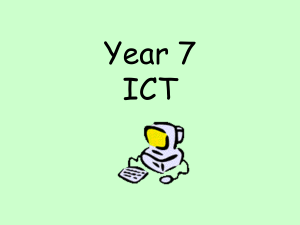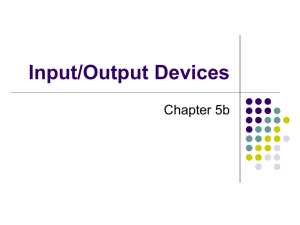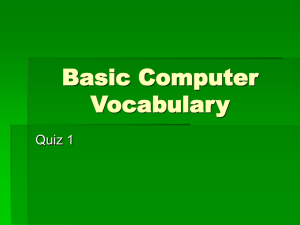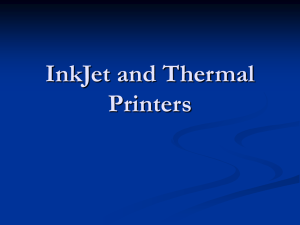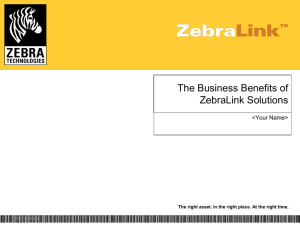A+ Guide to Managing and Maintaining Your PC, 5e
advertisement
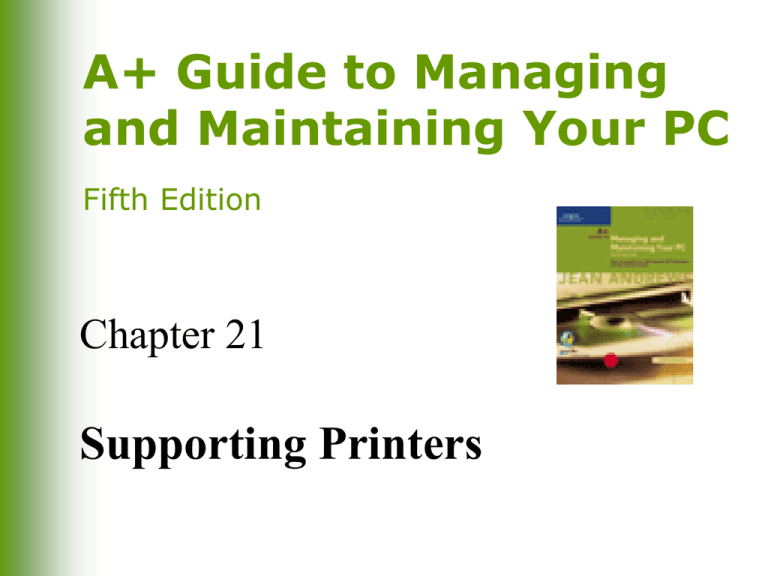
A+ Guide to Managing and Maintaining Your PC Fifth Edition Chapter 21 Supporting Printers You Will Learn… How printers work How to install printers and share them over a local area network How to troubleshoot printer problems A+ Guide to Managing and Maintaining Your PC, Fifth Edition 2 How Printers Work Connect to a PC by parallel, serial, USB, IEEE 1394, or SCSI port, or by infrared, wireless, PC Card, or network connection Can be combined with fax machines, copiers and scanners in the same machine Most often use AC power A+ Guide to Managing and Maintaining Your PC, Fifth Edition 3 Major Categories of Printers Impact printers Dot-matrix Non-impact printers Laser (highest quality) Inkjet Solid ink Dye-sublimation Thermal A+ Guide to Managing and Maintaining Your PC, Fifth Edition 4 Laser Printers A+ Guide to Managing and Maintaining Your PC, Fifth Edition 5 How a Laser Printer Works Places toner on electrically charged rotating drum Deposits toner on paper as paper moves through system at same speed the drum is turning A+ Guide to Managing and Maintaining Your PC, Fifth Edition 6 Six Steps of Laser Printing 1. Cleaning 2. Conditioning Take place inside toner cartridge Use components that undergo the most wear 3. Writing 4. Developing 5. Transferring 6. Fusing A+ Guide to Managing and Maintaining Your PC, Fifth Edition 7 Six Steps of Laser Printing (continued) 1. Cleaning Cleans drum of residual toner & electrical charge 2. Conditioning Conditions drum to contain high electrical charge 3. Writing Laser beam discharges a lower charge to only those places where toner is to go 4. Developing Toner is placed onto drum where the charge has been reduced 5. Transferring Strong electrical charge draws toner off drum onto paper; takes place outside the cartridge 6. Fusing Heat and pressure fuse toner to paper A+ Guide to Managing and Maintaining Your PC, Fifth Edition 8 Six Steps of Laser Printing (continued) A+ Guide to Managing and Maintaining Your PC, Fifth Edition 9 Step 1: Cleaning A+ Guide to Managing and Maintaining Your PC, Fifth Edition 10 Step 2: Conditioning A+ Guide to Managing and Maintaining Your PC, Fifth Edition 11 Step 3: Writing A+ Guide to Managing and Maintaining Your PC, Fifth Edition 12 Step 3: Writing Data from PC is received by formatter (1) and passed to DC controller (2) which controls laser unit (3) Scanning mirror (4) is turned clockwise by scanning motor Laser beam is reflected off scanning mirror, focused by focusing lens (5) and sent to the mirror (6) Mirror deflects laser beam to a slit in removable cartridge and on to the drum (7) A+ Guide to Managing and Maintaining Your PC, Fifth Edition 13 Step 3: Writing (continued) A+ Guide to Managing and Maintaining Your PC, Fifth Edition 14 Step 4: Developing A+ Guide to Managing and Maintaining Your PC, Fifth Edition 15 Step 4: Developing (continued) A+ Guide to Managing and Maintaining Your PC, Fifth Edition 16 Step 5: Transferring A+ Guide to Managing and Maintaining Your PC, Fifth Edition 17 Step 6: Fusing A+ Guide to Managing and Maintaining Your PC, Fifth Edition 18 Inkjet Printers A+ Guide to Managing and Maintaining Your PC, Fifth Edition 19 Inkjet Printers (continued) Use ink-dispersion printing Popular: small and print color inexpensively Most give photo-quality results (eg, PhotoREt II color technology) Paper quality affects quality of printed output Slower than lasers A+ Guide to Managing and Maintaining Your PC, Fifth Edition 20 How an Inkjet Printer Works Print head moves across paper, creating one line of text with each pass Shoots ionized ink at a sheet of paper in a matrix of small dots Several technologies are used to form ink droplets (eg, bubble-jet) Require ink cartridges Nozzles tend to clog or dry out Can be cleaned automatically A+ Guide to Managing and Maintaining Your PC, Fifth Edition 21 Inkjet Printer Ink Cartridges A+ Guide to Managing and Maintaining Your PC, Fifth Edition 22 Dot-Matrix Printers Less expensive; lesser quality Print multicopy documents (impact printer) Print head moves across the paper, using pins to shoot against a cloth ribbon and print a matrix of dots If print head fails, buy a new printer A+ Guide to Managing and Maintaining Your PC, Fifth Edition 23 Dot-Matrix Printers (continued) A+ Guide to Managing and Maintaining Your PC, Fifth Edition 24 Thermal Printers and Solid Ink Printers Relatively new printer technologies Non-impact printers that use heat to produce printed output A+ Guide to Managing and Maintaining Your PC, Fifth Edition 25 Thermal Printers Use wax-based ink heated by pins that melt ink onto paper Popular in retail for printing bar codes and price tags Variation: dye-sublimation printer A+ Guide to Managing and Maintaining Your PC, Fifth Edition 26 Solid Ink Printers Store ink in solid blocks that melts into print head which spans width of paper Print head jets liquid ink onto paper as it passes by on the drum Simple design, excellent print quality, easy to set up and maintain Takes print head ~15 minutes to heat up A+ Guide to Managing and Maintaining Your PC, Fifth Edition 27 Installing and Sharing a Printer Local printers Network printers Default printer A+ Guide to Managing and Maintaining Your PC, Fifth Edition 28 Installing a Local Printer Physically attach printer to computer Install printer drivers Have Windows do it Use printer manufacturer’s installation program (recommended) Test the printer A+ Guide to Managing and Maintaining Your PC, Fifth Edition 29 Sharing a Printer with Others in a Workgroup To share a local printer using Windows File and Printer Sharing must be installed To use a shared printer on a remote PC Client for Microsoft Networks must be installed A+ Guide to Managing and Maintaining Your PC, Fifth Edition 30 Using a Shared Printer Approaches to installing shared network printer drivers on remote PC Use drivers on CD Use printer drivers on host PC A+ Guide to Managing and Maintaining Your PC, Fifth Edition 31 Using a Shared Printer (continued) A+ Guide to Managing and Maintaining Your PC, Fifth Edition 32 Using a Shared Printer (continued) A+ Guide to Managing and Maintaining Your PC, Fifth Edition 33 Using a Shared Printer (continued) A+ Guide to Managing and Maintaining Your PC, Fifth Edition 34 Ways to Make a Printer Available on a Network Attach regular printer to a PC using a port on the PC PC can share printer with network Connect network printer with embedded logic to manage network communication directly to network with its own NIC Use a print server to control several printers A+ Guide to Managing and Maintaining Your PC, Fifth Edition 35 Troubleshooting Guidelines for Printers How Windows handles print jobs Printer maintenance General printer troubleshooting How to troubleshoot problems specific to laser, inkjet, and dot-matrix printers A+ Guide to Managing and Maintaining Your PC, Fifth Edition 36 How Windows Handles Print Jobs Windows NT/2000/XP or Windows 9x using a PostScript printer Converts print job data to PostScript language Windows 2000/XP can also use Printer Control Language (PCL) Windows 9x using a non-PostScript printer Converts print job data to Enhanced Metafile Format (EMF) A+ Guide to Managing and Maintaining Your PC, Fifth Edition 37 How Windows Handles Print Jobs (continued) Text data lacking embedded control characters is sent as raw data (DOS) Spooling A+ Guide to Managing and Maintaining Your PC, Fifth Edition 38 Printer Maintenance Procedures Vary depending on manufacturer and printer Make sure consumables for printer are on hand Research printer documentation or manufacturer’s Web site for specific maintenance tips During routine maintenance, clean inside and outside of the printer A+ Guide to Managing and Maintaining Your PC, Fifth Edition 39 Using Printer Manufacturer’s Web Site as a Resource Online documentation Knowledge base of common problems and what to do about them Updated device drivers Flash BIOS updates Catalog of options and upgrades for purchase A+ Guide to Managing and Maintaining Your PC, Fifth Edition 40 Using Printer Manufacturer’s Web Site as a Resource (continued) Replacement parts Printer maintenance kits Additional software A+ Guide to Managing and Maintaining Your PC, Fifth Edition 41 General Printer Troubleshooting Isolate the problem Application attempting to use the printer OS and printer drivers Connectivity between PC and printer Printer itself • Verify that a printer self-test page can print A+ Guide to Managing and Maintaining Your PC, Fifth Edition 42 Isolating a Printer Problem A+ Guide to Managing and Maintaining Your PC, Fifth Edition 43 Problems with Laser Printers Poor print quality or a Toner Low message is displayed Printer stays in warm-up mode Paper jam occurs or Paper Out message appears White streaks appear in the print A+ Guide to Managing and Maintaining Your PC, Fifth Edition 44 Problems with Laser Printers (continued) Print appears speckled Printed images are distorted Printing is slow Portion of the page does not print Is there a dead mouse in the printer? A+ Guide to Managing and Maintaining Your PC, Fifth Edition 45 A+ Guide to Managing and Maintaining Your PC, Fifth Edition 46 Problems with Inkjet Printers Poor print quality Intermittent or absent printing Lines or dots missing from printed page Ink streaks appear on the printed page A+ Guide to Managing and Maintaining Your PC, Fifth Edition 47 Problems with Inkjet Printers (continued) A+ Guide to Managing and Maintaining Your PC, Fifth Edition 48 Problems with Dot-Matrix Printers Print quality is poor Print head moves back and forth but nothing prints A+ Guide to Managing and Maintaining Your PC, Fifth Edition 49 Troubleshooting Printer Problems Problems printing from Windows Troubleshooting printing from applications Troubleshooting networked printers A+ Guide to Managing and Maintaining Your PC, Fifth Edition 50 Summary Main types of printers and how they work Laser Inkjet Dot-matrix How to install a printer How to share a printer with others on a network How to troubleshoot printer problems A+ Guide to Managing and Maintaining Your PC, Fifth Edition 51
